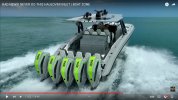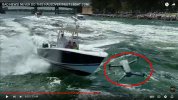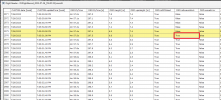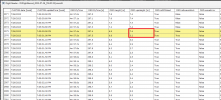"Landing Protection" is not a feature designed for use in unintentional landings.
It can
prevent unintentional landings.
I demonstrated that in the first of four videos in this playlist.
If you hold the throttle stick slightly lowered, causing the drone to slowly sink, it'll only descend to 2ft (0.5m) above ground no matter how long you hold the throttle partially down. That's because Landing Protection prevents it from going any lower. From there you need to hold the stick fully down [
more than 85%] to confirm your intent to engage auto-landing.
It's a feature designed to help the drone land on suitable ground when intentionally landing.
More accurately, Landing Protection is a feature designed to
prevent the drone from landing on unsuitable ground.
[...] are you possibly assuming the drone in this thread initiated a surprise landing? I see no indication in the flight log that it was attempting to land at any point.
No, I wasn't suggesting that at all. I was only questioning the advice of covering the VPS sensors with gaffer tape as though that could prevent the VPS from ever
causing an unwanted ditching into water.
I've only seen people suggest using tape to disable VPS since DJI Fly does not offer access to that setting. There are certainly some (less common) flying scenarios where VPS is more of a nuisance than a help, so disabling it can sometimes be beneficial.
I mentioned that in my same video. For example, if you're trying to fly through a narrow gap between branches. The VPS height sensor detects a branch closer than 2ft underneath and Landing Protection kicks in to automatically raise the drone, whereupon the drone hits the branch above it. Or you're flying through a small window frame. Same thing, the VPS height sensor sees the window frame closer than 2ft below, then Landing Protection automatically raises the drone, and presto it hits the top of the window frame.
So yes, there are situations where it sure would be nice if DJI allowed the option of disabling Landing Protection. But the DJI Fly app doesn't provide that configuration option. The Litchi app however does provide this option, as shown in my videos.
My only question is why people would think it's a good idea, or even a necessity, to disable the VPS system whenever flying over water as they believe the VPS could somehow cause the drone to drop into the water, when there's no mechanism to explain how that could ever happen.
People have documented many cases where the VPS sensors can trigger and force an uncommanded ascent when the drone isn't anywhere near the ground.
It doesn't have to be near the ground itself. It only needs the VPS height sensors to detect "something" within 2ft of its underside. That could be the top of a bush or tree, or it could be some object suspended and dangling from the drone itself, or even any "solid" enough fog bank.
If the VPS height sensor registers anything within 2ft, Landing Protection automatically causes the drone to rise up.
If that's possible and not mentioned in any DJI manuals, then I don't think other possibilities can be ruled out either just because they are not documented and/or you don't routinely experience it with your Mini.
The DJI manuals are quite vague about the behaviour of VPS, without providing explanation of why it behaves the way it does, merely warning it can be "confused" under certain conditions.
I have once experienced what I
thought was an uncommanded auto-landing
descent caused by the VPS height sensor on my Mini. But with the help from others on this forum that was diagnosed to have been caused by the VPS infrared height sensor detecting mist coming off the waterfall, and registering that as being closer than 2ft below, even though the drone was still high up above the water's surface.
What confused me was that my flight log data proved the throttle stick was never fully depressed. So what triggered auto-landing to commence from that height?
It turns out the throttle doesn't even need to be
fully depressed. Auto-landing is also triggered when all three of these conditions are simultaneously met;
- VPS height is registering 2ft or less, and
- throttle is continuously held anywhere below centre for 3 secs or more, and
- at some point within those 3 secs the throttle dips below 85% closed.
That's exactly what happened. The drone was descending with partially closed throttle for more than three seconds, then encountered mist spraying off the waterfall closer than 2ft below, and the throttle momentarily dipped below 85% closed (never fully closed), when the app suddenly announced "Landing"!
The VPS didn't
cause the drone to unexpectedly drop from the sky. My holding the throttle down triggered auto-landing, which is exactly as it is programmed to do under the three required conditions. Luckily I had plenty of time to cancel the auto-landing.
If you're flying only 2ft above a lake's surface, and holding the throttle partiallly down for more than 3 seconds, Landing Protection may be preventing the drone from going any lower. But if you also momentarily dip the throttle more than 85% closed, that combination will trigger auto-landing and you'll have only a brief moment to react before the drone sinks into the water. All you need to do to stop it is raise the throttle, as shown in my first video. But you need to be paying attention to realize what's going on and react accordingly.
Again, it's not the VPS that's causing the drone to sink into the lake. Landing Protection is busy trying to
prevent that from happening, not allowing the drone to go lower than 2ft above the water. But if the VPS infrared height sensor signal is being absorbed by the water, rather than reliably reflected back, or if you've stuck gaffer tape over the sensors to prevent them from working, there's nothing preventing you from manually driving the drone into the water.
That's the reason I question why anyone thinks it's a good idea to block the sensors while flying over water? The optical sensor, maybe yes. It can be fooled into tracking moving objects while hovering. But the infrared height sensors cannot create an
uncommanded descent.
If I'm wrong about that, I'd really appreciate anyone demonstrating how.














